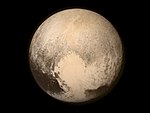astro.wikisort.org - Star
2MASS J19383260+4603591 (commonly abbreviated to 2M J1938+4603, also known as Kepler-451) is a binary star system with at least one known planet, Kepler-451b. The system comprises two stars, a pulsating subdwarf B star as well as a small red dwarf star.[3]
| Observation data Epoch J2000 Equinox J2000 | |
|---|---|
| Constellation | Cygnus |
| Right ascension | 19h 38m 32.61s[1] |
| Declination | 46h 03m 59.1s[1] |
| Characteristics | |
| Spectral type | sdBV/M |
| Astrometry | |
| Proper motion (μ) | RA: 5.23±0.04 mas/yr[2] Dec.: -4.40±0.04 mas/yr[2] |
| Parallax (π) | 2.4400 ± 0.0316 mas[2] |
| Distance | 1,340 ± 20 ly (410 ± 5 pc) |
| Orbit[3] | |
| Period (P) | 0.12576528 d |
| Details | |
| Kepler-451 A | |
| Mass | 0.48±0.03[1] [4] M☉ |
| Radius | 0.223±0.004/0.158±0.003[1] [4] R☉ |
| Temperature | 29564±106[1][4] K |
| Age | 6±2 Gyr |
| Kepler-451 B | |
| Mass | 0.120±0.010 M☉ |
| Other designations | |
| Database references | |
| SIMBAD | data |
Planetary system
It has at least one confirmed exoplanet, Kepler-451b, discovered in 2015[6] by the Kepler spacecraft. The discovery was disputed in 2020,[3] but in 2022 confirmation of Kepler-451b and the discovery of two additional planets was announced.[7]
| Companion (in order from star) |
Mass | Semimajor axis (AU) |
Orbital period (days) |
Eccentricity | Inclination | Radius |
|---|---|---|---|---|---|---|
| d | 1.76±0.18 MJ | 0.20±0.03 | 43.0±0.1 | 0 | — | — |
| b | 1.86±0.05 MJ | 0.90±0.04 | 406±4 | 0.33±0.05 | <43[3]° | — |
| c | 1.61±0.14 MJ | 2.1±0.2 | 1460±90 | 0.29±0.07 | — | — |
References
- "2MASS J19383260+4603591 b/Kepler-451 b CONFIRMED PLANET OVERVIEW PAGE". NASA Exoplanet Archive. Retrieved 2015-10-09.
- Brown, A. G. A.; et al. (Gaia collaboration) (2021). "Gaia Early Data Release 3: Summary of the contents and survey properties". Astronomy & Astrophysics. 649: A1. arXiv:2012.01533. Bibcode:2021A&A...649A...1G. doi:10.1051/0004-6361/202039657. S2CID 227254300. (Erratum: doi:10.1051/0004-6361/202039657e). Gaia EDR3 record for this source at VizieR.
- Krzesinski, J.; Blokesz, A.; Siwak, M.; Stachowski, G. (2020), "The quest for planets around subdwarfs and white dwarfs from Kepler space telescope fields", Astronomy & Astrophysics, 642: A105, arXiv:2009.02749, doi:10.1051/0004-6361/202038121, S2CID 221516872
- "2MASS J19383260+4603591 system". Open Exoplanet Catalog. Retrieved 2015-10-09.
- "Kepler-451". SIMBAD. Centre de données astronomiques de Strasbourg. Retrieved 2019-05-09.
- Detection of a planet in the sdB + M dwarf binary system 2M 1938+4603
- Ekrem Murat Esmer; Baştürk, Özgür; Selim Osman Selam; Aliş, Sinan (2022), Detection of two additional circumbinary planets around Kepler-451, arXiv:2202.02118
Текст в блоке "Читать" взят с сайта "Википедия" и доступен по лицензии Creative Commons Attribution-ShareAlike; в отдельных случаях могут действовать дополнительные условия.
Другой контент может иметь иную лицензию. Перед использованием материалов сайта WikiSort.org внимательно изучите правила лицензирования конкретных элементов наполнения сайта.
Другой контент может иметь иную лицензию. Перед использованием материалов сайта WikiSort.org внимательно изучите правила лицензирования конкретных элементов наполнения сайта.
2019-2025
WikiSort.org - проект по пересортировке и дополнению контента Википедии
WikiSort.org - проект по пересортировке и дополнению контента Википедии


